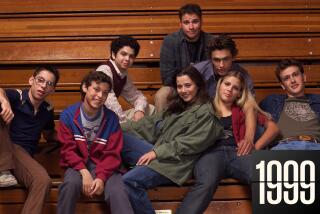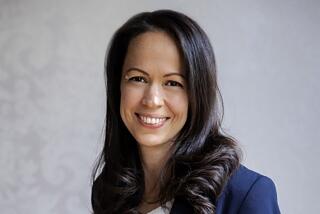Isaac Asimov, Science Fiction Virtuoso, Dies
- Share via
Isaac Asimov, the biochemist and prolific author with an infinite imagination who penned nearly 500 books of science fact and fiction, died Monday in New York. He was 72.
Stanley Asimov, a vice president of Newsday, said his brother died early Monday morning at New York University Hospital of heart and kidney failure.
The author, who won a remarkable number of Hugo awards for science fiction, said earlier this year that a prostate operation had slowed him down, prompting him to suspend his monthly column in Fantasy and Science Fiction magazine. He had contributed 400 columns and articles to the periodical over 33 years.
Despite a heart attack in 1977 and triple bypass surgery in 1983, Asimov had continued producing 10 or more books each year.
Once asked what he would do if a doctor gave him only six months to live, Asimov answered promptly: “Type faster!”
He told another interviewer that he worried about dying and having his brain decay, but cheered himself by saying, “I don’t have to worry about that, because there isn’t an idea I’ve ever had that I haven’t put down on paper.”
His final novel, “Forward the Foundation,” is scheduled for publication by Bantam later this year.
Fifteen of his novels, including the one not yet published, describe future civilizations spread throughout the stars, with solicitous robots serving humans.
Asimov set up the literary laws for fictional robots in 1950 in his second novel, “I, Robot.” The three laws were:
- Robots may not injure a human, or by inaction allow a human to be harmed.
- Robots must obey humans’ orders unless they conflict with the first law.
- Robots must protect their own existence unless that conflicts with the first two laws.
Until the film world introduced the destructive “Terminator,” Asimov’s laws had a definite softening effect on literary robots.
Aside from his science fiction, Asimov was probably best known for several factual science books, “The Realm of Numbers” (1959), “The Intelligent Man’s Guide to Science” (1960) and “The Genetic Code” (1963).
In a 1988 interview with The Times, he left no doubt that writing always came first in his life.
“Everything else is done only occasionally and under protest,” he said amiably. “Me and my typewriter, that’s all there is in the world.”
Typing more than 90 words per minute, he frequently worked 12-hour days and his output could easily reach 4,000 words a day. Claiming it was easier to write new material than polish up old, he would abandon any piece if it required more than one rewrite.
Although Asimov translated and adapted a Rene Laloux animated film, “Light Years,” he generally eschewed science fiction screenwriting.
“I’m really not a very visual person,” he told The Times. “But also, I want full control of all my work. My books appear as I write them, and I’ve a feeling of ownership--even my editors don’t argue with me.
“If I were to do a movie,” he continued, “it might reach 100 times more people than my books, but that movie would be a very diluted Asimov.
“Also, it might sound somewhat elitist, but I value the quality of my readers,” he said. “If I only have 1% of all book readers, I have the best readers.”
Asimov had no regrets about turning down Stephen Spielberg’s request that he write the screenplay for “Close Encounters of the Third Kind.”
“I didn’t know who he (Spielberg) was at the time, or what a hit the film would be, but I certainly wasn’t interested in a film that glorified flying saucers,” he said. “I still would have refused, only with more regret.”
Science fiction films, he believed, wrongly sacrificed plot and storytelling for glamorous special effects.
“Frankly,” he told The Times, “I’d rather sit at home and write my books.”
One of his books, “Fantastic Voyage,” a 1966 novel about a medical team that was miniaturized and injected into the bloodstream of a dying man, was made into a movie starring Raquel Welch.
Most of his fiction stuck closely to scientific fact, but Asimov conceded that he slipped a bit with “Fantastic Voyage” because the miniaturized medics would have been too small to breathe a molecule of oxygen.
Asimov was born Jan. 2, 1920, in Petrovichi in the Soviet Union. When he was 3, his family moved to New York, where his parents opened a candy store and Asimov was soon reading the pulp science fiction novels they stocked.
“I imagine there must be such a thing as a born writer,” he once wrote. “At least I can’t remember when I wasn’t on fire to write.”
At 15, he graduated from Boys High School and enrolled at Columbia University, where he subsequently earned his bachelor’s, master’s and doctoral degrees in chemistry. Other than writing, his only occupation was as occasional instructor at Boston University Medical School.
He began writing short science fiction stories as a teen-ager and, after 12 rejections, made his first sale, “Marooned Off Vesta,” to Amazing Stories in 1938.
During World War II he interrupted his education to work as a chemist at the Naval Air Experimental Station in Philadelphia from 1942 to 1945 and to serve in the Army from 1945 to 1946.
His first book of science fiction, published by Doubleday in 1950, was “Pebble in the Sky,” about a man transported by a nuclear accident from the 20th Century to the Galactic Era 827.
Of “Pebble in the Sky,” Critic Margaret C. Scoggin wrote: “A nice satire on our own racial intolerances and our own militarists. . . . (The book is) well plotted with a minimum of jargon.”
The science fiction novels flowed after that, as did the Hugo Awards from the World Science Fiction Convention.
Asimov earned Hugos in virtually every category--for the best series of all time in 1966 for the trilogy “Foundation,” “Foundation and Empire” and “Second Foundation”; for distinguished contributions to the field in 1963; for science articles in the Magazine of Fantasy and Science Fiction in 1966; for best novel in 1973 for “The Gods Themselves” and in 1983 for “Foundation’s Edge”; and for best short story, “The Bicentennial Man,” in 1977.
Further establishing him as outstanding in his field, the Science Fiction Writers of America selected his “Nightfall” as the best science fiction story of all time in a poll taken in the late 1980s.
“No single author has ever written more books about more subjects than Isaac Asimov,” Time magazine once noted of the man others have called “the writing machine.”
Asimov married twice, first to Gertrude Blugerman, the mother of his son and daughter, David and Robyn Joan. After their divorce in 1973, he married psychiatrist Janet Opal Jeppson, who survives. In addition to his brother, Asimov is survived by a sister, Marcia Rapanes.
(Southland Edition) Selected Works
Isaac Asimov formed an elaborate vision of the future in his 15 “Foundation” and robot books. They were written out of chronological order but Asimov said they went this way: 1. “The Complete Robot,” 1982. This included stories from the original collection, “I, Robot,” 1950. 2. “The Caves of Steel,” 1954. 3. “The Naked Sun,” 1957. 4. “The Robots of Dawn,” 1983. 5. “Robots and Empire,” 1985. 6. “The Currents of Space,” 1952. 7. “The Stars, Like Dust,” 1951. 8. “Pebble in the Sky,” 1950. 9. “Prelude to Foundation,” 1988. 10. “Forward the Foundation,” to be published later this year. 11. “Foundation,” 1951. 12. “Foundation and Empire,” 1952. 13. “Second Foundation,” 1953. 14. “Foundation’s Edge,” 1982. 15. “Foundation and Earth,” 1983. Asimov’s code of conduct for robots, suggested in his 1950 classic science fiction novel “I, Robot”:
Robots may not injure a human or, by inaction, allow a human to be injured.
Robots must obey humans’ orders unless they conflict with the first law.
Robots must protect their own existence unless that conflicts with the first two laws.
SOURCE: Associated Press
More to Read
Sign up for our Book Club newsletter
Get the latest news, events and more from the Los Angeles Times Book Club, and help us get L.A. reading and talking.
You may occasionally receive promotional content from the Los Angeles Times.








